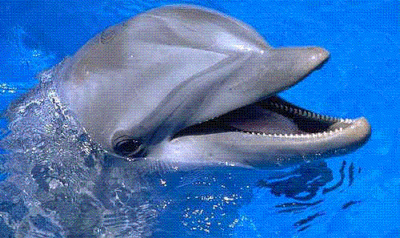Bottlenose Dolphin
Category: Dolphin

Facts about Bottlenose Dolphin, "Scientific name for Bottlenose Dolphin is Tursiops truncatus". Bottlenose dolphin is the most common dolphin species. It is also the most well known dolphin species, due to their presence alongside ships, on television shows and sea life aquarium demonstrations. It is named for its bottle shaped snout.
Bottlenose dolphins communicate via squeaks and whistles. Studies of their language suggest unique identifiers for individuals, suggesting that they have names.
Bottlenose dolphins are highly social animals, living in groups called pods. A pod may have anywhere from ten to a thousand individuals. Dolphin pods hunt together and will help an injured member stay near the surface to breathe.
Bottlenose dolphins live in temperate and tropical oceans around the world. They grow to be three to four meters or ten to fourteen feet in length. The Bottlenose dolphins weigh approximately 500 kilograms or 1,100 pounds when grown.
They are exclusively carnivorous. Bottlenose dolphins primarily eat fish, though they will eat shrimp and squid. They locate fish via echolocation or sonar. Bottlenose dolphins often ride in the waves alongside ships, enjoying the faster travel it provides, but they will also circle fishing boats hoping to eat the discarded dead fish.
Bottlenose dolphins are no longer hunted for meat and oil, as whales used to be hunted for oil for lamps. However, they are still regularly caught up in fishing nets. If they are trapped below the surface, they can drown. This is what spawned the “dolphin safe†label for tuna fish, since nets to catch tuna tended to kill dolphins as well.
Bottlenose dolphins are extremely intelligent. They have been observed to use tools like sponges. The Bottlenose dolphins can teach others to use tools and communicate concepts across generations. Dolphins in captivity have been taught to locate sea mines, use artificial language by pointing to symbols on a board to communicate with researchers and do tricks.
Dolphins in captivity live forty to fifty years. Those in the wild tend to live around twenty years.
It was originally thought that all bottle nose dolphins were the same species, but genetic surveys revealed in 2011 that the Burrunan dolphins near Australia and the Indo-Pacific dolphins are separate species.
"Scientific name for Dolphin Cetacea"-Meaning (large aquatic mammals having a horizontally flattened tail and forelimbs that adapted into flippers, or one to two nostrils at the top of its head for breathing, and no hind limbs. Cetaceans include all porpoises, dolphins and whales). "KÄ“tos" is the Greek word for whale and is where the scientific word comes from "Cetacean". "Fear of Dolphins delfiniphobia"

 Back To Category Dolphin
Back To Category Dolphin